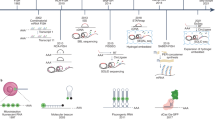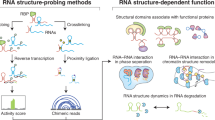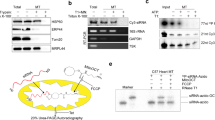Abstract
The term RNA interference (RNAi) describes the use of double-stranded RNA to target specific mRNAs for degradation, thereby silencing their expression. RNAi is one manifestation of a broad class of RNA silencing phenomena that are found in plants, animals and fungi. The discovery of RNAi has changed our understanding of how cells guard their genomes, led to the development of new strategies for blocking gene function, and may yet yield RNA-based drugs to treat human disease.
This is a preview of subscription content, access via your institution
Access options
Subscribe to this journal
Receive 12 print issues and online access
$189.00 per year
only $15.75 per issue
Buy this article
- Purchase on Springer Link
- Instant access to full article PDF
Prices may be subject to local taxes which are calculated during checkout


Similar content being viewed by others
References
Guo, S. & Kemphues, K.J. par-1, a gene required for establishing polarity in C. elegans embryos, encodes a putative Ser/Thr kinase that is asymmetrically distributed. Cell 81, 611–620 (1995).
Fire, A. et al. Potent and specific genetic interference by double-stranded RNA in Caenorhabditis elegans. Nature 391, 806–811 (1998).
Montgomery, M.K., Xu, S. & Fire, A. RNA as a target of double-stranded RNA-mediated genetic interference in Caenorhabditis elegans. Proc. Natl. Acad. Sci. USA 95, 15502–15507 (1998).
Hammond, S.M., Bernstein, E., Beach, D. & Hannon, G.J. An RNA-directed nuclease mediates post-transcriptional gene silencing in Drosophila cells. Nature 404, 293–296 (2000).
Zamore, P., Tuschl, T., Sharp, P. & Bartel, D. RNAi: double-stranded RNA directs the ATP-dependent cleavage of mRNA at 21 to 23 nucleotide intervals. Cell 101, 25–33 (2000).
Ketting, R.F. & Plasterk, R.H. A genetic link between co-suppression and RNA interference in C. elegans. Nature 404, 296–298 (2000).
Ketting, R.F., Haverkamp, T.H., van Luenen, H.G. & Plasterk, R.H. Mut-7 of C. elegans, required for transposon silencing and RNA interference, is a homolog of Werner syndrome helicase and RNaseD. Cell 99, 133–141 (1999).
Wu-Scharf, D., Jeong, B., Zhang, C. & Cerutti, H. Transgene and transposon silencing in chlamydomonas reinhardtii by a DEAH-Box RNA helicase. Science 290, 1159–1163 (2000).
Aravin, A.A. et al. Double-stranded RNA-mediated silencing of genomic tandem repeats and transposable elements in the D. melanogaster germline. Curr. Biol. 11, 1017–1027 (2001).
Gonczy, P. et al. Functional genomic analysis of cell division in C. elegans using RNAi of genes on chromosome III. Nature 408, 331–336 (2000).
Fraser, A.G. et al. Functional genomic analysis of C. elegans chromosome I by systematic RNA interference. Nature 408, 325–330 (2000).
Kennerdell, J.R. & Carthew, R.W. Use of dsRNA-mediated genetic interference to demonstrate that frizzled and frizzled 2 act in the wingless pathway. Cell 95,1017–1026 (1998).
Misquitta, L. & Paterson, B.M. Targeted disruption of gene function in Drosophila by RNA interference (RNA-i): a role for nautilus in embryonic somatic muscle formation. Proc. Natl. Acad. Sci. USA 96, 1451–1456 (1999).
Hughes, C.L. & Kaufman, T.C. RNAi analysis of Deformed, proboscipedia and Sex combs reduced in the milkweed bug Oncopeltus fasciatus: novel roles for Hox genes in the hemipteran head. Development 127, 3683–3694. (2000).
Ngo, H., Tschudi, C., Gull, K. & Ullu, E. Double-stranded RNA induces mRNA degradation in Trypanosoma brucei. Proc. Natl. Acad. Sci. USA 95, 14687–14692 (1998).
Sánchez-Alvarado, A. & Newmark, P.A. Double-stranded RNA specifically disrupts gene expression during planarian regeneration. Proc. Natl. Acad. Sci. USA 96, 5049–5054 (1999).
Lohmann, J.U., Endl, I. & Bosch, T.C. Silencing of Developmental Genes in Hydra. Dev. Biol. 214, 211–214 (1999).
Elbashir, S.M. et al. Duplexes of 21-nucleotide RNAs mediate RNA interference in mammalian cell culture. Nature 411, 494–498 (2001).
Elbashir, S.M., Lendeckel, W. & Tuschl, T. RNA interference is mediated by 21- and 22-nucleotide RNAs. Genes & Dev. 15, 188–200 (2001).
Bernstein, E., Caudy, A.A., Hammond, S.M. & Hannon, G.J. Role for a bidentate ribonuclease in the initiation step of RNA interference. Nature 409, 363–366 (2001).
Cogoni, C., Romano, N. & Macino, G. Suppression of gene expression by homologous transgenes. Antonie Van Leeuwenhoek 65, 205–209 (1994).
Cogoni, C. et al. Transgene silencing of the al-1 gene in vegetative cells of Neurospora is mediated by a cytoplasmic effector and does not depend on DNA–DNA interactions or DNA methylation. EMBO J. 15, 3153–3163 (1996).
Aravind, L., Watanabe, H., Lipman, D.J. & Koonin, E.V. Lineage-specific loss and divergence of functionally linked genes in eukaryotes. Proc. Natl. Acad. Sci. USA 97, 11319–11324 (2000).
Tuschl, T., Zamore, P.D., Lehmann, R., Bartel, D.P. & Sharp, P.A. Targeted mRNA degradation by double-stranded RNA in vitro. Genes & Dev. 13, 3191–3197 (1999).
Hamilton, A.J. & Baulcombe, D.C. A species of small antisense RNA in posttranscriptional gene silencing in plants. Science 286, 950–952 (1999).
Yang, D., Lu, H. & Erickson, J.W. Evidence that processed small dsRNAs may mediate sequence-specific mRNA degradation during RNAi in Drosophila embryos. Curr. Biol. 10, 1191–1200 (2000).
Parrish, S., Fleenor, J., Xu, S., Mello, C. & Fire, A. Functional anatomy of a dsRNA trigger. Differential requirement for the two trigger strands in RNA interference. Mol. Cell 6, 1077–1087 (2000).
Jacobsen, S.E., Running, M.P. & Meyerowitz, E.M. Disruption of an RNA helicase/RNase III gene in Arabidopsis causes unregulated cell division in floral meristems. Development 126, 5231–5243 (1999).
Ray, A., Lang, J.D., Golden, T. & Ray, S. SHORT INTEGUMENT (SIN1), agene required for ovule development in Arabidopsis, also controls flowering time. Development 122, 2631–2638 (1996).
Ray, S., Golden, T. & Ray, A. Maternal effects of the short integument mutation on embryo development in Arabidopsis. Dev. Biol. 180, 365–369 (1996).
Grishok, A. et al. Genes and mechanisms related to RNA interference regulate expression of the small temporal RNAs that control C. elegans developmental timing. Cell 106, 23–34 (2001).
Hutvágner, G. et al. A cellular function for the RNA-interference enzyme dicer in the maturation of the let-7 small temporal RNA. Science, 293, 834–838 (2001).
Cerutti, L., Mian, N. & Bateman, A. Domains in gene silencing and cell differentiation proteins: the novel PAZ domain and redefinition of the Piwi domain. Trends Biochem. Sci. 481–482 (2000).
Grishok, A., Tabara, H. & Mello, C. Genetic requirements for inheritance of RNAi in C. elegans. Science 287, 2494–2497 (2000).
Dernburg, A.F., Zalevsky, J., Colaiácovo, M.P. & Villeneuve, A.M. Transgene-mediated cosuppression in the C. elegans germ line. Genes & Dev. 14,1578–1583 (2000).
Cogoni, C. & Macino, G. Isolation of quelling-defective (qde) mutants impaired in posttranscriptional transgene-induced gene silencing in Neurospora crassa. Proc. Natl. Acad. Sci. USA 94, 10233–10238 (1997).
Fagard, M., Boutet, S., Morel, J.-B., Bellini, C. & Vaucheret, H. AGO1, QDE-2,and RDE-1 are related proteins required for post-transcriptional gene silencing in plants, quelling in fungi, and RNA interference in animals. Proc. Natl. Acad. Sci. USA 97, 11650–11654 (2000).
Tabara, H. et al. The rde-1 gene, RNA interference, and transposon silencing in C. elegans. Cell 99, 123–132 (1999).
Sharp, P.A. & Zamore, P.D. RNA interference. Science 287, 2431–2433 (2000).
Catalanotto, C., Azzalin, G., Macino, G. & Cogoni, C. Transcription: Gene silencing in worms and fungi. Nature 404, 245 (2000).
Fire, A. RNA-triggered gene silencing. Trends Genet. 15, 358–363 (1999).
Cogoni, C. & Macino, G. Gene silencing in Neurospora crassa requires a protein homologous to RNA-dependent RNA polymerase. Nature 399, 166–169 (1999).
Smardon, A. et al. EGO-1 is related to RNA-directed RNA polymerase and functions in germ-line development and RNA interference in C. elegans. Curr. Biol. 10, 169–178 (2000).
Dalmay, T., Hamilton, A., Rudd, S., Angell, S. & Baulcombe, D.C. An RNA-dependent RNA polymerase gene in Arabidopsis is required for posttranscriptional gene silencing mediated by a transgene but not by a virus. Cell 101, 543–553 (2000).
Mourrain, P. et al. Arabidopsis SGS2 and SGS3 genes are required for posttranscriptional gene silencing and natural virus resistance. Cell 101,533–542 (2000).
Qiao, L. et al. Enhancers of glp-1, a gene required for cell-signaling in Caenorhabditis elegans, define a set of genes required for germline development. Genetics 141, 551–569 (1995).
Li, W.X. & Ding, S.W. Viral suppressors of RNA silencing. Curr Opin Biotechnol 12, 150–154 (2001).
Brigneti, G. et al. Viral pathogenicity determinants are suppressors of transgene silencing in Nicotiana benthamiana. EMBO J. 17, 6739–6746 (1998).
Lucy, A.P., Guo, H.S., Li, W.X. & Ding, S.W. Suppression of post-transcriptional gene silencing by a plant viral protein localized in the nucleus. EMBO J. 19,1672–1680 (2000).
Llave, C., Kasschau, K.D. & Carrington, J.C. Virus-encoded suppressor of posttranscriptional gene silencing targets a maintenance step in the silencing pathway. Proc. Natl. Acad. Sci. USA 97, 13401–13406 (2000).
Mallory, A.C. et al. HC-Pro suppression of transgene silencing eliminates the small RNAs but not transgene methylation or the mobile signal. Plant Cell 13,571–583 (2001).
Voinnet, O., Lederer, C. & Baulcombe, D.C. A viral movement protein prevents spread of the gene silencing signal in Nicotiana benthamiana. Cell 103, 157–167 (2000).
Acknowledgements
I would like to thank my colleagues for generously sharing their ideas with me, notably D. Bartel, C. Mello, A. Fire, P. Sharp, and T. Tuschl, and I especially thank the members of my own laboratory, with whom it is a great privilege to study RNAi.
Author information
Authors and Affiliations
Rights and permissions
About this article
Cite this article
Zamore, P. RNA interference: listening to the sound of silence. Nat Struct Mol Biol 8, 746–750 (2001). https://doi.org/10.1038/nsb0901-746
Received:
Accepted:
Issue Date:
DOI: https://doi.org/10.1038/nsb0901-746
This article is cited by
-
In vivo inhibition of the Ostreid Herpesvirus-1 (OsHV-1) replication in juveniles of the Pacific oyster Crassostrea gigas by a specific RNAi targeting the viral DNA polymerase gene
Aquaculture International (2023)
-
Chemical engineering of therapeutic siRNAs for allele-specific gene silencing in Huntington’s disease models
Nature Communications (2022)
-
Virus-induced gene silencing (VIGS) in Cannabis sativa L.
Plant Methods (2019)
-
Delivery of a Genetically Marked Serratia AS1 to Medically Important Arthropods for Use in RNAi and Paratransgenic Control Strategies
Microbial Ecology (2019)
-
shRNA mediated knockdown of Nav1.7 in rat dorsal root ganglion attenuates pain following burn injury
BMC Anesthesiology (2015)



